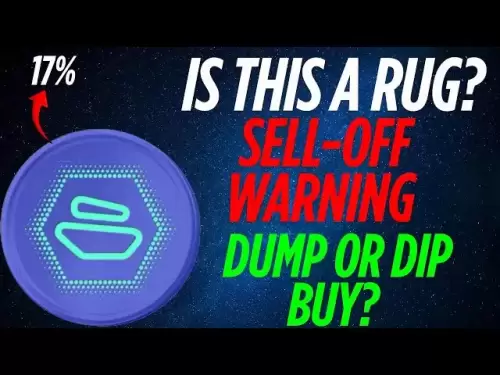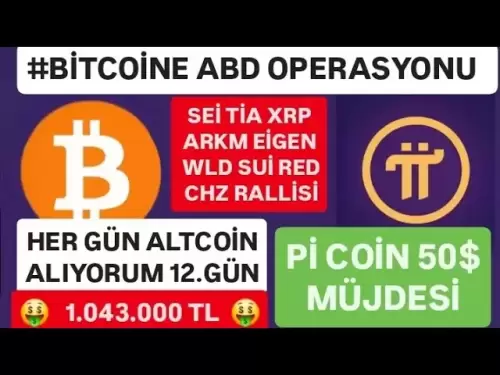-
 Bitcoin
Bitcoin $108,010.6153
-0.99% -
 Ethereum
Ethereum $2,535.1451
-1.14% -
 Tether USDt
Tether USDt $1.0002
-0.01% -
 XRP
XRP $2.2599
-0.33% -
 BNB
BNB $660.3442
-0.18% -
 Solana
Solana $149.0762
-1.43% -
 USDC
USDC $0.9999
0.00% -
 TRON
TRON $0.2866
-0.41% -
 Dogecoin
Dogecoin $0.1669
-2.73% -
 Cardano
Cardano $0.5765
-1.53% -
 Hyperliquid
Hyperliquid $38.5005
-2.98% -
 Bitcoin Cash
Bitcoin Cash $496.7709
-0.04% -
 Sui
Sui $2.8522
-2.12% -
 Chainlink
Chainlink $13.2812
-1.50% -
 UNUS SED LEO
UNUS SED LEO $9.0486
0.17% -
 Stellar
Stellar $0.2466
-2.57% -
 Avalanche
Avalanche $17.8271
-2.84% -
 Shiba Inu
Shiba Inu $0.0...01158
-1.66% -
 Toncoin
Toncoin $2.7359
-4.01% -
 Hedera
Hedera $0.1563
-1.78% -
 Litecoin
Litecoin $85.8096
-1.80% -
 Monero
Monero $313.7645
-2.86% -
 Dai
Dai $1.0002
0.02% -
 Polkadot
Polkadot $3.3494
-1.35% -
 Ethena USDe
Ethena USDe $1.0003
0.03% -
 Bitget Token
Bitget Token $4.2980
-3.40% -
 Uniswap
Uniswap $7.3906
-0.28% -
 Aave
Aave $280.1449
-2.34% -
 Pepe
Pepe $0.0...09833
-2.41% -
 Pi
Pi $0.4546
-2.21%
Can KuCoin contract be held for a long time
Traders evaluating the long-term viability of KuCoin Contracts should consider market conditions, funding rates, volatility, margin requirements, and employ risk management strategies for prudent trading.
Nov 14, 2024 at 02:50 pm

Can KuCoin Contracts Be Held for a Long Time?
Introduction
KuCoin Contracts, a robust platform for perpetual contracts, offers traders access to a wide range of cryptocurrencies with up to 100x leverage. While perpetual contracts are typically designed for short-term trading, the question arises: can traders hold KuCoin Contracts for an extended period? This article delves into the intricacies of holding such positions, exploring the potential risks and benefits, and providing a comprehensive guide for evaluating the long-term viability of KuCoin Contracts.
Understanding KuCoin Contracts
KuCoin Contracts are perpetual contracts, a type of derivative where traders can take leveraged positions on the future price of an underlying cryptocurrency without an expiration date. This allows them to benefit from price fluctuations without owning the asset itself. While this flexibility offers significant potential for profit, it's crucial to understand the unique characteristics of perpetual contracts:
- No Expiration: Perpetual contracts do not have a predetermined expiration date, unlike traditional futures contracts. Traders can maintain their positions for an indefinite period, subject to margin requirements and other platform rules.
- Funding Rate: Perpetual contracts employ a funding rate mechanism to ensure price alignment with the spot market. This rate, typically paid hourly, compensates traders who hold long or short positions based on market demand.
- Leverage and Risk: Perpetual contracts offer high leverage, allowing traders to amplify their potential profits. However, this increased leverage also magnifies risks, and traders can lose more than their initial investment if market conditions turn unfavorable.
Factors Influencing Long-Term Viability
When considering holding KuCoin Contracts for a long time, several key factors come into play:
- Market Conditions: The long-term viability of KuCoin Contracts is heavily influenced by market conditions. In bullish markets, traders may find holding long positions profitable as the underlying cryptocurrency's value increases. Conversely, in bearish markets, holding short positions could be more advantageous.
- Funding Rate: The funding rate plays a crucial role in determining the profitability of holding perpetual contracts over the long term. If the funding rate is consistently favorable, traders may be incentivized to hold their positions indefinitely. However, an unfavorable funding rate can erode profits or even push traders into a loss.
- Volatility: Perpetual contracts are typically more sensitive to price volatility than spot trading. Extended periods of low volatility can limit trading opportunities and hinder profitability. Conversely, high volatility can offer increased chances of profit but also introduce higher risks.
- Margin Requirements: Traders must maintain sufficient margin in their accounts to cover potential losses. In highly volatile markets or with high leverage, margin requirements can fluctuate significantly, forcing traders to adjust their positions or risk liquidation.
Steps for Evaluating Long-Term Holding Suitability
To assess whether KuCoin Contracts are suitable for long-term holding, traders should consider the following steps:
- Define Trading Goals: Clearly define your trading goals, whether it's long-term profit accumulation or hedging against market volatility. This will help you determine the appropriate holding period.
- Thoroughly Research: Study the underlying cryptocurrency, market trends, and historical funding rates to make informed decisions about holding positions over the long term.
- Risk Management: Employ robust risk management strategies, including stop-loss orders, to limit potential losses. Carefully evaluate your risk appetite and leverage level to avoid excessive exposure.
- Monitor Market Conditions: Continuously monitor market conditions and funding rates to make timely adjustments to your positions. Stay informed about major news events or industry developments that could impact your trades.
- Consider Scalping or Hedging: For traders seeking long-term exposure without continuous position holding, scalping or hedging strategies may be more appropriate. These techniques involve shorter time frames and can help mitigate risks associated with holding contracts for extended periods.
Conclusion
Holding KuCoin Contracts for a long time can be a viable strategy, but it requires a thorough understanding of market dynamics, funding rates, and risk management principles. By carefully considering these factors and employing a prudent trading approach, traders can navigate the complexities of perpetual contracts and potentially harness their potential for long-term profit. However, it's important to note that perpetual contracts are leveraged instruments that carry inherent risks, and traders should always exercise caution and sound judgment.
Disclaimer:info@kdj.com
The information provided is not trading advice. kdj.com does not assume any responsibility for any investments made based on the information provided in this article. Cryptocurrencies are highly volatile and it is highly recommended that you invest with caution after thorough research!
If you believe that the content used on this website infringes your copyright, please contact us immediately (info@kdj.com) and we will delete it promptly.
- Ethereum, Exchanges, and Price Resilience: Navigating the Crypto Landscape
- 2025-07-08 08:30:13
- Bitcoin's NVT Golden Cross: Is a Local Top Brewing?
- 2025-07-08 09:10:11
- Semler Scientific's Bitcoin Bonanza: A Cryptocurrency Goal?
- 2025-07-08 09:10:11
- From Coin Flips to Cityscapes: How Names, Parks, and Planting Shaped St. Albert
- 2025-07-08 08:50:12
- Candles, Laundromats, and Inspiration: A Surprising New York Story
- 2025-07-08 09:15:11
- Iron Maiden Rocks the Royal Mint: A 50th Anniversary Coin That Kicks Ass
- 2025-07-08 09:15:11
Related knowledge

How to identify the contract value range in combination with the market profile?
Jul 02,2025 at 10:56pm
Understanding the Market ProfileTo effectively identify the contract value range in combination with the market profile, it's essential to first understand what each concept entails. The market profile is a framework that helps traders visualize how price and time interact across a given period, typically a trading day or session. It provides insights i...

How to use the price slope to filter the false breakthrough signal of the contract?
Jun 20,2025 at 06:56pm
Understanding the Concept of Price Slope in Contract TradingIn contract trading, especially within cryptocurrency derivatives markets, price slope refers to the rate at which the price changes over a specific time period. It helps traders assess the strength and sustainability of a trend. A steep slope may indicate strong momentum, while a shallow slope...

How to determine the expected volatility of the contract through the volatility cone?
Jun 19,2025 at 12:28pm
Understanding the Basics of Volatility in Cryptocurrency ContractsIn the realm of cryptocurrency trading, volatility is a key metric that traders use to assess potential risk and reward. When dealing with futures contracts, understanding how volatile an asset might become over time is crucial for position sizing, risk management, and strategy developmen...

How to formulate a contract intraday trading plan in combination with the pivot point system?
Jun 21,2025 at 03:42pm
Understanding the Basics of Pivot Points in Cryptocurrency TradingPivot points are technical analysis tools used by traders to identify potential support and resistance levels. These levels are calculated using the previous day's high, low, and closing prices. In the context of cryptocurrency trading, where markets operate 24/7, pivot points help trader...

How to adjust the contract position ratio through the price fluctuation entropy?
Jun 22,2025 at 11:42am
Understanding Price Fluctuation Entropy in Cryptocurrency ContractsIn the world of cryptocurrency futures trading, price fluctuation entropy is a relatively new concept used to measure market volatility and uncertainty. It derives from information theory, where entropy refers to the degree of randomness or unpredictability in a system. In crypto contrac...

How to use the volume swing indicator to predict the contract volume-price divergence?
Jun 18,2025 at 11:42pm
Understanding the Volume Swing IndicatorThe volume swing indicator is a technical analysis tool used primarily in cryptocurrency trading to evaluate changes in volume over time. Unlike price-based indicators, this metric focuses solely on trading volume, which can provide early signals about potential market reversals or continuations. The key idea behi...

How to identify the contract value range in combination with the market profile?
Jul 02,2025 at 10:56pm
Understanding the Market ProfileTo effectively identify the contract value range in combination with the market profile, it's essential to first understand what each concept entails. The market profile is a framework that helps traders visualize how price and time interact across a given period, typically a trading day or session. It provides insights i...

How to use the price slope to filter the false breakthrough signal of the contract?
Jun 20,2025 at 06:56pm
Understanding the Concept of Price Slope in Contract TradingIn contract trading, especially within cryptocurrency derivatives markets, price slope refers to the rate at which the price changes over a specific time period. It helps traders assess the strength and sustainability of a trend. A steep slope may indicate strong momentum, while a shallow slope...

How to determine the expected volatility of the contract through the volatility cone?
Jun 19,2025 at 12:28pm
Understanding the Basics of Volatility in Cryptocurrency ContractsIn the realm of cryptocurrency trading, volatility is a key metric that traders use to assess potential risk and reward. When dealing with futures contracts, understanding how volatile an asset might become over time is crucial for position sizing, risk management, and strategy developmen...

How to formulate a contract intraday trading plan in combination with the pivot point system?
Jun 21,2025 at 03:42pm
Understanding the Basics of Pivot Points in Cryptocurrency TradingPivot points are technical analysis tools used by traders to identify potential support and resistance levels. These levels are calculated using the previous day's high, low, and closing prices. In the context of cryptocurrency trading, where markets operate 24/7, pivot points help trader...

How to adjust the contract position ratio through the price fluctuation entropy?
Jun 22,2025 at 11:42am
Understanding Price Fluctuation Entropy in Cryptocurrency ContractsIn the world of cryptocurrency futures trading, price fluctuation entropy is a relatively new concept used to measure market volatility and uncertainty. It derives from information theory, where entropy refers to the degree of randomness or unpredictability in a system. In crypto contrac...

How to use the volume swing indicator to predict the contract volume-price divergence?
Jun 18,2025 at 11:42pm
Understanding the Volume Swing IndicatorThe volume swing indicator is a technical analysis tool used primarily in cryptocurrency trading to evaluate changes in volume over time. Unlike price-based indicators, this metric focuses solely on trading volume, which can provide early signals about potential market reversals or continuations. The key idea behi...
See all articles

























































































